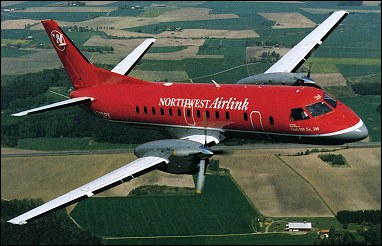 |
Saab 3401983 |  |
| PASSENGER | Virtual Aircraft Museum / Sweden / Saab |
 |
In January 1980 Saab-Scania and Fairchild Industries in the USA announced simultaneously the intention of the two companies to design and develop a new transport aircraft. This unique European/US collaboration in the field of civil aviation led to the maiden flight of the first Saab-Fairchild 340 prototype (SE-ISF) on 25 January 1983. This, plus a second prototype (SE-ISA) and the first production aircraft (SE-ISB flown on 25 August 1983) participated in the certification programme which saw JAR and FAA approval granted by 29 June 1984. Initial deliveries were made to Crossair, in Switzerland. A cantilever low-wing monoplane of basic all-metal structure with the selective use of composite materials, the aircraft is of conventional configuration; it has a fail-safe pressurised fuselage structure, retractable tricycle landing gear with twin wheels on each unit, and is powered by two turboprop engines in wing-mounted nacelles. Fairchild was responsible for design and manufacture of the wings, tail unit and engine nacelles, while Saab, which funded 75 per cent of the development costs, handled the fuselage, systems integration flight-testing and certification. The aircraft itself comprises a round-section fuselage seating up to 35 passengers with a flight attendant and two-person crew. The wing uses NASA-developed low-drag airfoil technology, and two General Electric CT7 turboprops were chosen as powerplants. Initially two versions were on offer: the basic air transport configuration and an executive version. The first of these 'biz-props' was sold to Pittsburgh's Mellon Bank. The type suffered a setback in 1984 when it was temporarily grounded, after Crossair suffered inflight engine shut downs, but these teething troubles were soon rectified and Saab pressed on with the next stage in the aircraft's development. In 1985, at the Paris air show, Saab launched a 340 with uprated CT7 engines driving larger Dowty propellers. Maximum take-off weight was increased from the original 11,793kg to 12,872kg. Existing SF-340s were offered the improvement as a modification programme. As a result of an ailing financial position Fairchild withdrew from the SF-340 programme in October 1985, and production was gradually transferred in its entirety to Saab's Linkoping home, south of Stockholm. Next version to be offered was the freighter S340QC which, as its name suggests, was a quick-change cargo aircraft, the first of which was delivered to Finnaviation in 1987. In that same year, as Saab severed its final links with Fairchild, the family was renamed the S340. 1987 also saw the launch of the Saab 340B, the current production version, which features higher power output CT7-9B engines, a larger span tailplane, and a further increased maximum takeoff weight of 12,928kg. Crossair was again the launch customer for this version. The arrival of the Saab 340 had a significant effect on sales figures, which had been slowing at that point, having reached 200 aircraft. By mid-1993 Saab 340 orders had exceeded 400, with over 340 delivered, to 28 airlines and four corporate clients. One of the most recent orders has been for the Saab 340AEW Erieye airborne early warning aircraft, the contract for which was signed by the Swedish air force on 3 February 1993. This version features an Ericsson phased array surveillance radar above 1he fuselage, with three operators in the cabin and a mission endurance of up to seven hours. Six aircraft are anticipated lor Swedish service with an initial in-service date of 1995. The most recently announced improvements to the Saab 340 will enhance the aircraft's hot-and-high performance and short field capability, through a 0.6m wingtip extension. This increases the Saab 340's takeoff weight by 544kg, equivalent to six/seven passengers. A third-generation cabin interior, common to the Saab 2000, is also being introduced, along with modifications to the APU and optional low-pressure tyres.
|  COMPANY PROFILE | ||||||||||||||||||||||||||||||||||||||||||||||||||||||||
 |

|



20
reply